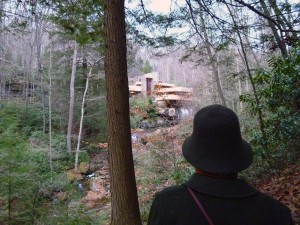 Random thoughts after a recent visit. Isn’t it strange that a millionaire’s plaything, a weekend house that cost a whopping $166,000 in 1937 ($2.6 million today), in which the servants outnumbered the occupants, and in which meals were served by a butler, should nevertheless have become the most popularly admired modern house in America. There are a number if explanations. I recently visited a huge (40,000 square feet) house designed by Paul Rudolph; it felt like being in a hotel lobby. Philip Johnson’s Glass House is much smaller, but most people couldn’t imagine living in it. Richard Meier’s Rachofsky House in Dallas is a beautiful purist composition, but it resembles a museum—which is its present function. Not so Fallingwater. The enclosed space is not large (about 2,900 square feet, plus 2,400 square feet of balconies), and although the living room is sprawling, the bedrooms are very small. And compared to a modern McMansion, it’s all downright Spartan; no marble bathrooms, no walk-in closets, no vast kitchen, no media room. The materials are unprepossessing, and the details are either simple or absent—there is none of that obsessive precision that makes modern houses feel like luxury cars. The luxury at Fallingwater is all in the cantilevered terraces, which feel like open-air tree houses. Like most visitors, I went down the path to experience the View. It is all one could ask for. But it is a mark of this curiously demure folly, that the iconic view is not seen as one approaches, or from any of the vantage points around the house, where the design is experienced in bits and pieces. It is as if Wright were saying, “Oh, by the way, you should see it from down there.”
Random thoughts after a recent visit. Isn’t it strange that a millionaire’s plaything, a weekend house that cost a whopping $166,000 in 1937 ($2.6 million today), in which the servants outnumbered the occupants, and in which meals were served by a butler, should nevertheless have become the most popularly admired modern house in America. There are a number if explanations. I recently visited a huge (40,000 square feet) house designed by Paul Rudolph; it felt like being in a hotel lobby. Philip Johnson’s Glass House is much smaller, but most people couldn’t imagine living in it. Richard Meier’s Rachofsky House in Dallas is a beautiful purist composition, but it resembles a museum—which is its present function. Not so Fallingwater. The enclosed space is not large (about 2,900 square feet, plus 2,400 square feet of balconies), and although the living room is sprawling, the bedrooms are very small. And compared to a modern McMansion, it’s all downright Spartan; no marble bathrooms, no walk-in closets, no vast kitchen, no media room. The materials are unprepossessing, and the details are either simple or absent—there is none of that obsessive precision that makes modern houses feel like luxury cars. The luxury at Fallingwater is all in the cantilevered terraces, which feel like open-air tree houses. Like most visitors, I went down the path to experience the View. It is all one could ask for. But it is a mark of this curiously demure folly, that the iconic view is not seen as one approaches, or from any of the vantage points around the house, where the design is experienced in bits and pieces. It is as if Wright were saying, “Oh, by the way, you should see it from down there.”
On Culture and Architecture

Felt the same way visiting the Meyer May house in Grand Rapids, MI. The house is best viewed from corner at the nearby intersection and the rooms are quite small, the only really pleasurable spaces being the living room and porch, like the Robie House. Maybe he wanted to push people outdoors or at least together in the living room by making the bedrooms almost unbearably small, which would’ve been odd in Midwestern climates that with winters.
On the other hand, each bedroom in the house has its own bathroom, which was unusual for 1938.And while the bedrooms are small, they are hardly unbearable places, with many windows and private terraces. The most compact, and to my eye the most attractive private space, is Edgar, Jr.’s suite on the top floor. And since the Kaufmanns were opinionated clients, one must assume that they got what they wanted. This was a weekend summer house, after all, and you wouldn’t spend that much time in your room.
Fallingwater is an excellent example, for me, of what an architect can do that a do-it-yourself amateur builder cannot do. The combination of Wright’s talent, Kaufmann’s money and intelligent oversight, and the site combine to create a memorable triumph. I would like to have spent a week there instead of mere hours.
I’m more divided than you guys are. Love the way the buildings look but find them absurd as houses. Here’s a bit I wrote about Fallingwater some years ago:
http://www.2blowhards.com/archives/000993.html